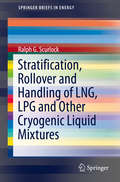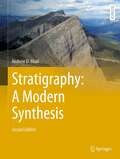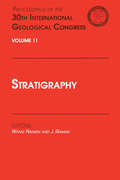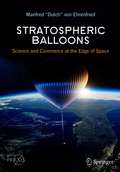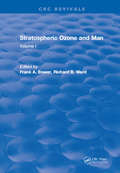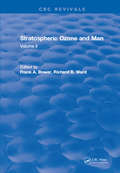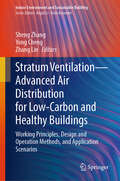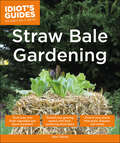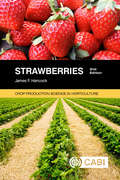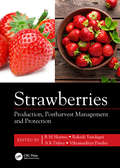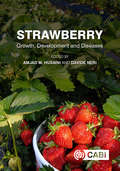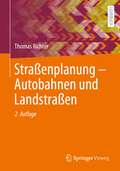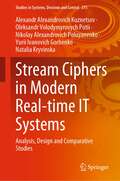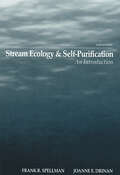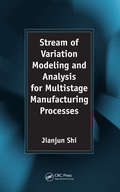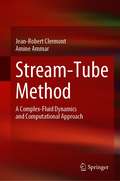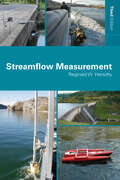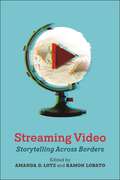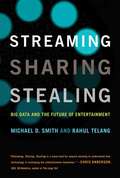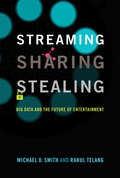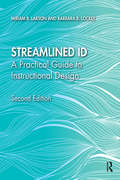- Table View
- List View
Stratification, Rollover and Handling of LNG, LPG and Other Cryogenic Liquid Mixtures
by Ralph G. ScurlockThis short, practical book offers advice on the safe storage, handling and transportation of liquid natural gas (LNG), liquid petroleum gas (LPG) and other cryogenic fluid mixtures. It begins with a review of the physical properties of LNG and LPG, and a brief overview of basic handling and storage methods. The chapters that follow address more in-depth topics such as heat flows in LNG and LPG storage systems, insulation techniques and surface evaporation phenomena. Two chapters are then devoted to the specific sequence of problems caused by stratification and rollover, and the techniques used to manage and alleviate these issues. The book then considers the use of vacuum insulated tanks for the storage of pressurised LNG, and the effective transfer of liquids avoiding 2-phase flow. It concludes with a summary of safe storage and handling protocols, and addresses the specific health issues encountered when dealing with cryogenic liquid mixtures. Throughout the book the author presents real-life case studies to illustrate the situation being discussed. Written in a practical style, it will prove an invaluable companion to anyone working with LNG, LPG or other cryogenic liquid mixtures.
Stratigraphy: A Modern Synthesis (Springer Textbooks in Earth Sciences, Geography and Environment)
by Andrew D. MiallThe updated textbook is intended to serve as an advanced and detailed treatment of the evolution of the subject of stratigraphy from its disparate beginnings as separate studies of sedimentology, lithostratigraphy, chronostratigraphy, etc., into a modern integrated discipline in which all components are necessary. There is a historical introduction, which now includes information about the timeline of the evolution of the components of modern stratigraphy. The elements of the various components (facies analysis, sequence stratigraphy, mapping methods, chronostratigraphic methods, etc.) are outlined, and a chapter discussing the modern synthesis is included near the end of the book, which closes with a discussion of future research trends in the study of time as preserved in the stratigraphic record.
Stratigraphy: Proceedings of the 30th International Geological Congress, Volume 11
by Wang NaiwenThis volume presents the proceedings of Symposium I "Stratigraphy" of the 30th International Geological Congress at Beijing. The proceedings aim to present a view of contemporary geology and should be of interest to researchers in the geological sciences.
Stratospheric Balloons: Science and Commerce at the Edge of Space (Springer Praxis Books)
by Manfred “Dutch” von EhrenfriedStratospheric balloons are powerful tools used to study the Earth and its atmosphere, as well as the greater cosmos beyond. This book describes the science and technology behind modern stratospheric ballooning, along with the surprising ways it has impacted our daily lives.The book takes you through every step of the process, starting with an in-depth introduction to basic balloon types and their uses before delving into balloon construction and mission planning. Along the way, you will learn about the novel technologies that have radically changed these balloons and their ability to launch, control and navigate them over specific ground targets. Next follows an exploration of their incredible applications, including research in atmospheric science, cosmology and astronomy, earth studies, meteorology, and aerobiology, and also commercial capabilities such as Internet networks and high-altitude tourism.The community of scientists, engineers, and entrepreneurs involved in stratospheric ballooning is only ever growing. This book shows you how these national and international efforts have truly soared in recent years, and it will be an enjoyable read for anybody interested in learning more about how science and commerce are conducted in the stratosphere, at the edge of space.
Stratospheric Ozone and Man: Volume I
by Frank A. BowerThe book, as originally conceived, was to be limited to technical considerations, but the scientific course of event has been so interwoven with non-scientific, but nevertheless related events, the authors felt necessary to include an account of this situation. Accordingly, the book is divided into five sections entitled: � Stratospheric ozone � Atmospheric processes influencing stratospheric ozone � Does man influence stratospheric ozone � Effects and research � Public policy
Stratospheric Ozone and Man: Volume II
by Frank A. BowerThe book, as originally conceived, was to be limited to technical considerations, but the scientific course of event has been so interwoven with non-scientific, but nevertheless related events, the authors felt necessary to include an account of this situation. Accordingly, the book is divided into five sections entitled: � Stratospheric ozone � Atmospheric processes influencing stratospheric ozone � Does man influence stratospheric ozone � Effects and research � Public policy
Stratum Ventilation—Advanced Air Distribution for Low-Carbon and Healthy Buildings: Working Principles, Design and Operation Methods, and Application Scenarios (Indoor Environment and Sustainable Building)
by Yong Cheng Sheng Zhang Zhang LinThis book investigates the creation of healthy and thermally comfortable built environments in a low-carbon manner with advanced air distribution, i.e., stratum ventilation. Stratum ventilation efficiently supplies conditioned and clean air to the head level of occupants for thermal comfort and inhaled air quality and largely reduces energy consumption and CO2 emission, e.g., by 44% and 32%, respectively, compared with the conventional air distribution method. This book provides the working principles, performance evaluations methods, design methods, operation methods, and different application scenarios (particularly highlighting airborne infection risk control of respiratory diseases and integrated application with renewable energy) of stratum ventilation, to provide theoretical understandings and technical guidelines of stratum ventilation. The book is intended for undergraduate and graduate students, researchers, and engineers who are interested in cutting-edge technologies of livable and sustainable built environments.
Stratégies de gestion du temps: Comment récupérer votre temps
by Tony GrayImaginez ce que vous pourriez accomplir tout au long de votre vie si vous adoptiez la discipline requise pour une bonne gestion du temps. Apprenez comment gérer votre temps de manière efficace et accomplissez toutes les tâches de votre to-do list en un temps record. Ce guide complet vous aidera à contrôler votre temps rapidement et à empêcher votre temps de vous contrôler. Dans ce livre, vous apprendrez… •Comment prioriser votre to-do list •Comment appliquer le principe des 80/20 dans votre vie •Comment empêcher le temps de vous échapper •Pourquoi le multi-tâches vous ralentira •Comment établir des attentes réalistes •Et plus encore ! Stratégies de gestion du temps pour les étudiants, stratégies de gestion du temps pour les enseignants et stratégies de gestion du temps pour le personnel infirmier et plus…
Straw Bale Gardening (Idiot's Guides)
by John TullockGardening has "grown" to be more popular than ever. Idiot's Guides: Straw Bale Gardening features a great way to grow vegetables — even when space is limited. Hundreds of helpful, step-by-step color photographs illustrate how to arrange, prepare, and successfully grow a straw bale garden. Professional advice on what to grow and how to maximize yield is also included.
Strawberries (Crop Production Science in Horticulture)
by James HancockThis new and updated edition of a popular text provides a broad, balanced review of the scientific knowledge of strawberries and their cultivation. The worldwide strawberry industry has grown substantially since the original book was published, and methods of culture have undergone extensive modifications. This volume incorporates important changes to the taxonomy of strawberries and new understanding of how its ancestors evolved. It includes coverage of new disease and pest control methods and recent developments in genomic information. These advancements have greatly improved our understanding of how flowering and fruiting is regulated, and will revolutionize the breeding of strawberries. Drawing on extensive research and practical experience, the author presents an essential text that: Includes new content on genomic data, trait genetics, and marker-assisted strategies for varietal improvement. Provides a thorough review of the evolution of the strawberry and the history of strawberry cultivation. Contains an up-to-date comparison of the cultural systems employed across the world and the physiology behind these practices. Presented in full-colour throughout, this is a core guide for academic and professional researchers, breeders and growers, advisors, extension personnel and students of horticulture.
Strawberries: Production, Postharvest Management and Protection
by Radha Mohan Sharma Rakesh Yamdagni Anil Kumar Dubey Vikramaditya PandeyThis book provides unparalleled integration of fundamentals and most advanced management to make this strawberry crop highly remunerative besides enhancing per capita availability of fruit even in the non-traditional regions of the world.
Strawberry
by Amjad M. Husaini Davide NeriMethods of strawberry cultivation have undergone extensive modification and this book provides an up-to-date, broad and balanced scientific review of current research and emerging challenges. Subjects covered range from plant propagation, architecture, genetic resources, breeding, abiotic stresses and climate change, to evolving diseases and their control. These topics are examined in three sections: - Genetics, Breeding and Omics - covering genetic resources, breeding, metabolomics, transcriptomics, and genetic transformation of strawberry. - Cultivation Systems and Propagation - discusses plant architecture, replanting problems and plant propagation techniques. - Disease and Stress Management - deals with traditional and emerging fungal diseases, their diagnosis and modern biocontrol strategies, and biotechnological interventions for dealing with the challenges of climate change. Strawberry: Growth, Development and Diseases is written by an international team of specialists, using figures and tables to make the subject comprehensible and informative. It is an essential resource for academics and industry workers involved in strawberry research and development, and all those interested in the commercial cultivation of strawberries.
Straßenplanung – Autobahnen und Landstraßen
by Thomas RichterDas Buch behandelt die Planung und den Entwurf von Autobahnen und Landstraßen. Aus der Netzplanung heraus werden die Qualitätsansprüche an die Straße hergeleitet. Nach einem Exkurs in die fahrdynamischen Grundlagen werden die Entwurfselemente im Lageplan, im Höhenplan und im Querschnitt beschrieben. Nach einer detaillierten Darstellung der Knotenpunktlösungen erfolgt noch eine Zusammenstellung der erforderlichen Ausstattung. Die zweite Auflage (Titel der ersten Auflage: Planung von Autobahnen und Landstraßen) berücksichtigt die aktuellen Forschungsergebnisse für Autobahnen und Landstraßen der letzten 10 Jahre sowie das aktuell erschienene Merkblatt zur Anwendung der Entwurfsklassen der RAL an bestehenden Landstraßen (M ERL). Ferner werden die zunehmende Bedeutung der Klimaneutralität und die möglichen Maßnahmen im Straßenentwurf thematisiert.
Stream Ciphers in Modern Real-time IT Systems: Analysis, Design and Comparative Studies (Studies in Systems, Decision and Control #375)
by Natalia Kryvinska Alexandr Alexandrovich Kuznetsov Oleksandr Volodymyrovych Potii Nikolay Alexandrovich Poluyanenko Yurii Ivanovich GorbenkoThis book provides the most complete description, analysis, and comparative studies of modern standardized and most common stream symmetric encryption algorithms, as well as stream modes of symmetric block ciphers. Stream ciphers provide an encryption in almost real-time regardless of the volume and stream bit depth of converted data, which makes them the most popular in modern real-time IT systems. In particular, we analyze the criteria and performance indicators of algorithms, as well as the principles and methods of designing stream ciphers. Nonlinear-feedback shift registers, which are one of the main elements of stream ciphers, have been studied in detail. The book is especially useful for scientists, developers, and experts in the field of cryptology and electronic trust services, as well as for the training of graduate students, masters, and bachelors in the field of information security.
Stream Ecology and Self Purification: An Introduction, Second Edition
by Frank R. Spellman Joanne DrinanThis new edition of a very successful standard reference is expanded and fully reworked. The book explains and quantifies the processes whereby streams cleanse themselves, reducing their pollutant load as a natural process. Mechanisms of purification in running waters have always been critical with regard to clearly identified pollution sources. Th
Stream Hydrology
by Christopher J. Gippel Rory J. Nathan Nancy D. Gordon Brian L. Finlayson Thomas A. McmahonSince the publication of the first edition (1994) there have been rapid developments in the application of hydrology, geomorphology and ecology to stream management. In particular, growth has occurred in the areas of stream rehabilitation and the evaluation of environmental flow needs. The concept of stream health has been adopted as a way of assessing stream resources and setting management goals.Stream Hydrology: An Introduction for Ecologists Second Edition documents recent research and practice in these areas. Chapters provide information on sampling, field techniques, stream analysis, the hydrodynamics of moving water, channel form, sediment transport and commonly used statistical methods such as flow duration and flood frequency analysis. Methods are presented from engineering hydrology, fluvial geomorphology and hydraulics with examples of their biological implications. This book demonstrates how these fields are linked and utilised in modern, scientific river management.Emphasis on applications, from collecting and analysing field measurements to using data and tools in stream management.Updated to include new sections on environmental flows, rehabilitation, measuring stream health and stream classification.Critical reviews of the successes and failures of implementation.Revised and updated windows-based AQUAPAK software.This book is essential reading for 2nd/3rd year undergraduates and postgraduates of hydrology, stream ecology and fisheries science in Departments of Physical Geography, Biology, Environmental Science, Landscape Ecology, Environmental Engineering and Limnology. It would be valuable reading for professionals working in stream ecology, fisheries science and habitat management, environmental consultants and engineers.
Stream of Variation Modeling and Analysis for Multistage Manufacturing Processes
by Jianjun ShiVariability arises in multistage manufacturing processes (MMPs) from a variety of sources. Variation reduction demands data fusion from product/process design, manufacturing process data, and quality measurement. Statistical process control (SPC), with a focus on quality data alone, only tells half of the story and is a passive method, taking corre
Stream-Tube Method: A Complex-Fluid Dynamics and Computational Approach
by Jean-Robert Clermont Amine AmmarThis book presents the stream-tube method (STM), a method offering computational means of dealing with the two- and three-dimensional properties of numerous incompressible materials in static and dynamic conditions. The authors show that the kinematics and stresses associated with the flow and deformation in such materials can be treated by breaking the system down into simple computational sub-domains in which streamlines are straight and parallel and using one or two mapping functions in steady-state and non-steady-state conditions.The STM is considered for various problems in non-Newtonian fluid mechanics with different geometries. The book makes use of examples and applications to illustrate the use of the STM. It explores the possibilities of computation on simple mapped rectangular domains and three-dimensional parallel-piped domains under different conditions. Complex materials with memory are considered simply without particle tracking problems.Readers, including researchers, engineers and graduate students, with a foundational knowledge of calculus, linear algebra, differential equations and fluid mechanics will benefit most greatly from this book.
Streamflow Measurement
by Reginald W. Herschy�Too little water or too much'? In either case streamflow measurement is crucial. Climate change could significant affect water resources and flood management. Streamflow measurement is necessary for efficient water management.This third edition deals with all the main current methods for measuring the flow in rivers and open channels, in accordanc
Streaming Video: Storytelling Across Borders (Critical Cultural Communication)
by Amanda D. Lotz and Ramon LobatoAn international team of experts explores how streaming services are disrupting traditional storytelling.The rise of streaming has dramatically transformed how audiences consume media. Over the last decade, subscription video-on-demand (SVOD) services, including Netflix, Prime Video, and Disney+, have begun commissioning and financing their own original movies and TV shows, changing the way and the rate at which content is produced across the globe, from Mexico City to Mumbai. Streaming Video maps this international production boom and what it means for producers, audiences, and storytellers. Through eighteen richly textured case studies, ranging from original Korean dramas on Netflix to BluTV’s experimental Turkish series, the book investigates how streaming services both disrupt and maintain storytelling traditions in specific national contexts. To what extent, and how, are streamers expanding norms of television and film storytelling in different parts of the world? Are streamers enabling the creation of content that would not otherwise exist? What are the implications for different viewers, in different countries, with different tastes? Together, the chapters critically assess the impacts of streaming on twenty-first century audiovisual storytelling and rethink established understandings of transnational screen flows.
Streaming, Sharing, Stealing: Big Data and the Future of Entertainment
by Rahul Telang Michael D. SmithTraditional network television programming has always followed the same script: executives approve a pilot, order a trial number of episodes, and broadcast them, expecting viewers to watch a given show on their television sets at the same time every week. But then came Netflix's House of Cards. Netflix gauged the show's potential from data it had gathered about subscribers' preferences, ordered two seasons without seeing a pilot, and uploaded the first thirteen episodes all at once for viewers to watch whenever they wanted on the devices of their choice. In this book, Michael Smith and Rahul Telang, experts on entertainment analytics, show how the success of House of Cards upended the film and TV industries -- and how companies like Amazon and Apple are changing the rules in other entertainment industries, notably publishing and music. We're living through a period of unprecedented technological disruption in the entertainment industries. Just about everything is affected: pricing, production, distribution, piracy. Smith and Telang discuss niche products and the long tail, product differentiation, price discrimination, and incentives for users not to steal content. To survive and succeed, businesses have to adapt rapidly and creatively. Smith and Telang explain how.How can companies discover who their customers are, what they want, and how much they are willing to pay for it? Data. The entertainment industries, must learn to play a little "moneyball." The bottom line: follow the data.
Streaming, Sharing, Stealing: Big Data and the Future of Entertainment
by Rahul Telang Michael D. SmithHow big data is transforming the creative industries, and how those industries can use lessons from Netflix, Amazon, and Apple to fight back. Traditional network television programming has always followed the same script: executives approve a pilot, order a trial number of episodes, and broadcast them, expecting viewers to watch a given show on their television sets at the same time every week. But then came Netflix's House of Cards. Netflix gauged the show's potential from data it had gathered about subscribers' preferences, ordered two seasons without seeing a pilot, and uploaded the first thirteen episodes all at once for viewers to watch whenever they wanted on the devices of their choice. In this book, Michael Smith and Rahul Telang, experts on entertainment analytics, show how the success of House of Cards upended the film and TV industries—and how companies like Amazon and Apple are changing the rules in other entertainment industries, notably publishing and music. We're living through a period of unprecedented technological disruption in the entertainment industries. Just about everything is affected: pricing, production, distribution, piracy. Smith and Telang discuss niche products and the long tail, product differentiation, price discrimination, and incentives for users not to steal content. To survive and succeed, businesses have to adapt rapidly and creatively. Smith and Telang explain how.How can companies discover who their customers are, what they want, and how much they are willing to pay for it? Data. The entertainment industries, must learn to play a little “moneyball.” The bottom line: follow the data.
Streamlined ID: A Practical Guide to Instructional Design
by Barbara B. Lockee Miriam B. LarsonStreamlined ID presents a focused and generalizable approach to instructional design and development—one that addresses the needs of ID novices as well as practitioners in a variety of career environments. Highlighting essentials and "big ideas," this guide advocates a streamlined approach to instructional design: producing instruction that is sustainable, optimized, appropriately redundant, and targeted at continuous improvement. The book’s enhanced version of the classic ADDIE model (Analysis, Design, Development, Implementation, and Evaluation) emphasizes the iterative nature of design and the role of evaluation throughout the design/development process. It clearly lays out a systematic approach that emphasizes the use of research-based theories, while acknowledging the need to customize the process to accommodate a variety of pedagogical approaches. This thoroughly revised second edition reflects recent advances and changes in the field, adds three new chapters, updates reference charts, job aids, and tips to support practitioners working in a variety of career environments, and speaks more clearly than ever to ID novices and graduate students.
Streamliner: Raymond Loewy and Image-making in the Age of American Industrial Design
by John WallThe true story of Raymond Loewy, whose designs are still celebrated for their unerring ability to advance American consumer taste.Born in Paris in 1893 and trained as an engineer, Raymond Loewy revolutionized twentieth-century American industrial design. Combining salesmanship and media savvy, he created bright, smooth, and colorful logos for major corporations that included Greyhound, Exxon, and Nabisco. His designs for Studebaker automobiles, Sears Coldspot refrigerators, Lucky Strike cigarette packs, and Pennsylvania Railroad locomotives are iconic. Beyond his timeless designs, Loewy carefully built an international reputation through the assiduous courting of journalists and tastemakers to become the face of both a new profession and a consumer-driven vision of the American dream.In Streamliner, John Wall traces the evolution of an industry through the lens of Loewy’s eclectic life, distinctive work, and invented persona. How, he asks, did Loewy build a business while transforming himself into a national brand a half century before "branding" became relevant? Placing Loewy in context with the emerging consumer culture of the latter half of the twentieth century, Wall explores how his approach to business complemented—or differed from—that of his well-known contemporaries, including industrial designers Henry Dreyfuss, Walter Teague, and Norman Bel Geddes. Wall also reveals how Loewy tailored his lifestyle to cement the image of "designer" in the public imagination, and why the self-promotion that drove Loewy to the top of his profession began to work against him at the end of his career. Streamliner is an important and engaging work on one of the longest-lived careers in industrial design.
Streamlining Digital Signal Processing
by Richard G. LyonsThis book presents recent advances in DSP to simplify, or increase the computational speed of, common signal processing operations. The topics describe clever DSP tricks of the trade not covered in conventional DSP textbooks. This material is practical, real-world, DSP tips and tricks as opposed to the traditional highly-specialized, math-intensive, research subjects directed at industry researchers and university professors. This book goes well beyond the standard DSP fundamentals textbook and presents new, but tried-and-true, clever implementations of digital filter design, spectrum analysis, signal generation, high-speed function approximation, and various other DSP functions.
